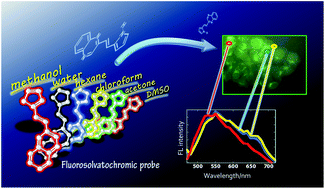Fluorosolvatochromic probes have recently attracted interest for live cell imaging. We recently tested our quinoxaline-based fluorosolvatochromic probes, PQX and MPQX, for in vivo imaging applications. PQX and MPQX are characterized by donor (pyrrole site)–acceptor (quinoxaline site) structure, and the peak emission wavelength of these compounds varies over the visible wavelength range depending on the polarity of the solvent used, for a variety of solvents from hexane to water. A linear relationship was obtained between peak emission wavenumber and ETN (normalized solvent polarity). When tested on cultured HEp-2 cells, the results showed that the PQX and MPQX were not harmful at the applied concentrations (10−5 M), and site-dependent fluorescence spectra in living cells were observed with PQX treatment, which indicates that PQX penetrates into the plasma membrane, followed by delocalization throughout the cells. MPQX was also able to penetrate the cell membrane, distribute throughout the cells and emit fluorescence, but did not show site-dependent intracellular fluorescence spectra. These results suggest that PQX is a remarkable tool for investigating the local polarity environment in cells after appropriate conjugation to biomolecules.

You have access to this article
 Please wait while we load your content...
Something went wrong. Try again?
Please wait while we load your content...
Something went wrong. Try again?


 Please wait while we load your content...
Please wait while we load your content...